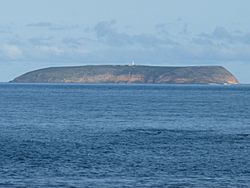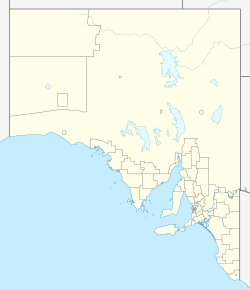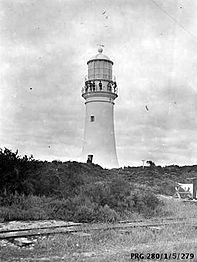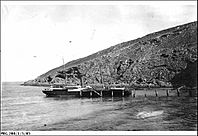Althorpe Islands facts for kids

Althorpe Island, South Australia
|
|
| Geography | |
|---|---|
| Location | Investigator Strait |
| Coordinates | 35°22′S 136°52′E / 35.367°S 136.867°E |
| Administration | |
|
Australia
|
|
The Althorpe Islands are a group of islands located in the Investigator Strait. This is off the southwest tip of the Yorke Peninsula in South Australia. The group includes Althorpe Island and two smaller rocky islands nearby. These islands are about 7.7 kilometers southwest of Cape Spencer on the mainland. Closer to shore are Seal Island and Haystack Island. All four islands are part of the Althorpe Islands Conservation Park. This park helps protect the islands' nature. The islands have no people living on them. You can only reach them by boat or helicopter.
Contents
Island History
First Sightings
European explorers first saw the Althorpe Islands on March 20, 1802. This was from the ship HMS Investigator, led by Matthew Flinders. The islands are thought to be named after the family home of George Spencer, 2nd Earl Spencer. His home, Althorp, is in Northamptonshire, England.
Early Visitors and Lighthouse
In October 1851, seal hunters visited the islands. They came on a small boat called the Jane and Emma. They caught fur seals, Cape Barren Geese, and mutton birds.
The lighthouse keepers' cottages on the island are very old and important. They show how the islands helped with sea trade and safety in the past. Building the Althorpe Island Lighthouse started in 1877. Sadly, an accident in 1878 killed the building foreman. This slowed down the work.
The lighthouse was finished and first lit in 1879. People called "keepers" lived on the island to operate and care for the light. They stayed there until 1991, when the lighthouse became automated. In 1886, a telephone cable was laid. It connected the Althorpe Islands to Cape Spencer on the mainland.
Today, the light works automatically. The Australian Maritime Safety Authority takes care of it.
Important Historical Places
Althorpe Island has several buildings and structures that are important to history. They are listed as heritage sites. These include:
- The Althorpe Island Jetty and Railway for Trolley
- The Althorpe Island Lighthouse
- The Althorpe Island Lighthouse Keepers' Cottages
Island Environment
In 1879, someone described Althorpe Island as a "bare and bleak" place. They said the plants were just small, scrubby bushes. These bushes seemed afraid to grow tall because of the strong winds. The flat top of the island was often swept by wild winds. These winds made the waves crash into foam on the rocks below.
Amazing Wildlife
The Althorpe Islands are home to many interesting animals. In 1845, people said the islands were visited by penguins and Cape Barren geese. The islands are very important for seabirds. This includes the white-bellied sea eagle (Haliaeetus leucogaster), which is an endangered bird in South Australia.
The smaller islands near Althorpe Island are resting spots for Australian sea lions (Neophoca cinerea). These sea lions are vulnerable both nationally and in the state. In 1888, the islands were called a "retreat" for penguins, gulls, and seals.
An old story from 1879 in the South Australian Register newspaper described the wildlife:
- "Mutton birds" (short-tailed shearwaters) dig their homes all over the islands.
- Seals play in quiet spots.
- Fast seagulls and serious shags make loud noises.
- Penguins, "like little lads in white pinafores," live in the cracks and holes of the rocks.
- Sometimes, huge sharks swim slowly around the ocean near the islands.
In 1951, a lighthouse keeper shared more about the island's animals:
- Penguins make their nests there during mating season. You can see their young in the rocky areas.
- From September to March, millions of mutton birds come from Siberia to nest. They dig their nests in the soil and under bushes. They literally cover the ground.
- Years ago, there were many seals on the island. But because many were hunted, very few, if any, are left today.
Little Penguin Colony
Many old newspaper stories from 1845 to 1902 mention little penguins on Althorpe Island. In 1845, penguins and Cape Barren geese were known to visit the island often. In 1883, W. Reddan said there were an "extraordinary" number of penguins. He said they were "everywhere." A visit by the Marine Board the next year noted that "Down on the rocks the penguins waddle about in large numbers."
In 1886, The Advertiser newspaper briefly mentioned the penguins. It said "pairs of whom were found peering with pensive eyes out of holes in the sandy rocks." In 1887, The South Australian Register also described them. It said "In crevices of the rocks innumerable birds find refuge, and in these and in holes in the sand the queer-shaped penguin also has its habitation."
By 1894, penguins were common along the island's rocks. In 1897, visitors described hearing "the eerie cry of the penguins."
There is a steep path from the jetty to the top of the island. It passes a cave known as the "Penguin Hotel." In 1902, a visitor said the inside of the cave was "honey-combed by penguins."
In 1996, a survey of South Australia's islands found many places where little penguins breed.
Little Penguin Decline
The number of little penguins (Eudyptula minor) on Althorpe Island seems to be going down. This was first noticed by comparing old stories of how many penguins there used to be with how few were found in a 2004 survey. In 2004, there were only 132 penguins. In 2011, experts said the colony was "declining from 'numerous' and 'common' in 1982."
A survey in 2013 counted how many burrows were active. They estimated there were 84 adult birds in half of the island's breeding area. These results show that the number of penguins is indeed decreasing.
Protecting the Islands
The Althorpe Islands are a protected area. This means they are special places where nature is kept safe. They became a fauna (animal) conservation reserve on March 16, 1967. This was done under a law called the Crown Lands Act 1929-1966. This protection helps keep the islands and their wildlife safe for the future.
Images for kids






